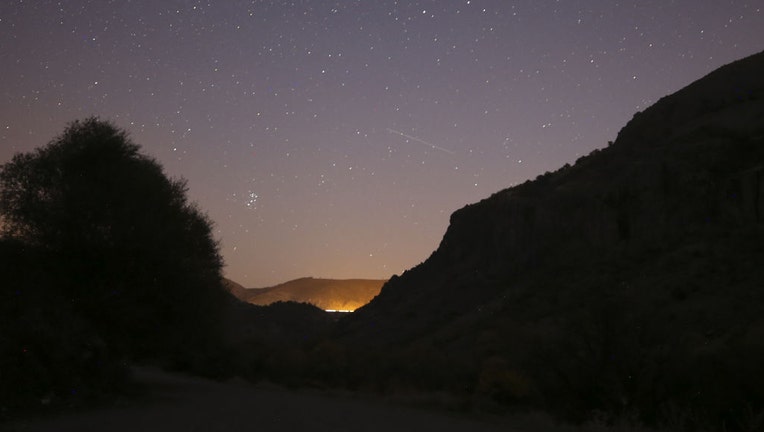Leonid meteor shower peaks this weekend: How and when to watch

FILE-A Leonids meteor streaks across the sky over Gudul district of Ankara, Turkey on November 17, 2020. (Photo by Dogukan Keskinkilic/Anadolu Agency via Getty Images)
It’s that time of the year again to enjoy the annual Leonid meteor shower.
Skywatchers can catch the meteor shower as it shoots across the sky on the night of Nov. 17-18, and it occurs when the Earth passes through the debris field left behind by the comet 55P/Tempel-Tuttle.
This spectacle happens each year in November and peaks toward the middle of the month. According to NASA, the Leonids are bright meteors, can also be colorful, and are deemed some of the fastest meteors.
RELATED: November night sky highlights: Jupiter on display, Leonid meteor shower peak
They’re also known for periodic storms every 33 years or so, which can result in hundreds to thousands of meteors seen per hour on Earth — depending on the viewer's location.
Where to watch the 2023 Leonid meteor shower and other viewing tips
The best time to view Leonids is around midnight local time. Skywatchers should find an area well away from the city or street lights. It’s also recommended to bring a sleeping bag, blanket, or lawn chair and orient yourself with your feet toward the east, lie flat on your back, and look up, taking in as much of the sky as possible.
NASA says that in under 30 minutes in the dark, your eyes will adapt, and you will begin to see meteors. Be patient – the show will last until dawn, so you have plenty of time to catch a glimpse.
RELATED: Watch: Fireball meteor soars across Colorado night sky
There are also plenty of good options to see the visual display, including at national parks, state parks or national forests.
The Leonids are visible to skywatchers in both the Northern and Southern Hemispheres.
According to the Planetary Society, these meteors appear to come from the area of the constellation Leo, which rises in the east in the hours after midnight during November. Meteors will streak out from this area in all directions.
What are Leonids?
The Leonids are bright meteors, can also be colorful, and are considered to be some of the fastest meteors out there, according to NASA.
They’re also known for periodic storms every 33 years or so, which can result in hundreds to thousands of meteors seen per hour on Earth — depending on the location of the viewer.
Leonids are also known for their fireballs, which are larger explosions of light and color that can persist longer than an average meteor streak, as well as "earthgrazers," which are meteors that streak close to the horizon and are known for their long and colorful tails, NASA says.
Where do the Leonid meteors come from?
Meteors come from leftover comet particles and bits from broken asteroids, according to NASA. The pieces of space debris that interact with our atmosphere to create the Leonids come from the comet 55P/Tempel-Tuttle.
When comets come around the sun, such as the comet 55P/Tempel-Tuttle does once every 33 years, the dust they emit gradually spreads into a dusty trail around their orbits.
Every year, the Earth passes through these trails of debris — which allows the bits to collide with our atmosphere where they disintegrate to create fiery streaks in the sky.
The Leonid shower is famous for producing meteor storms, according to EarthSky. Its parent comet Tempel-Tuttle releases fresh material every time it approaches the sun every 33 years, prompting the periodic storms.
The 1833 Leonid meteor storm produced more than 100,000 meteors an hour, EarthSky noted.
FOX national reporter Kelly Hayes contributed to this report. This story was reported from Washington, D.C.

